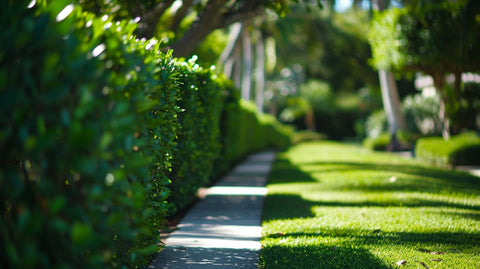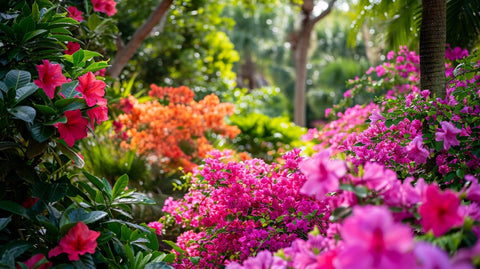florida hedge plants
Introduction | Types of Hedge Plants Thriving in Florida | Factors to Consider when Choosing a Hedge Plant for Florida | Design and Maintenance Tips for Florida Hedge Plants | Conclusion
Introduction
Florida, known for its tropical climate and diverse plant life, provides the perfect environment for lush, vibrant hedge plants. These natural barriers not only enhance the beauty and aesthetics of landscaping but also serve a functional purpose in defining boundaries and providing privacy. In this article, we will explore the importance of hedge plants in Florida landscaping and why this state is an ideal location for their growth and success.
Why Florida is an ideal location for hedge plants
Florida's warm climate, ample sunshine, and rich soil make it a prime location for the thriving growth of hedge plants. The state's subtropical and tropical regions provide the ideal conditions necessary for various hedge plant species to flourish year-round. Additionally, the state's extensive coastline and frequent rainfall further enhance the potential for robust plant growth, making Florida an optimal choice for homeowners and landscapers seeking to incorporate hedges into their outdoor spaces.
Types of Hedge Plants Thriving in Florida
When selecting hedge plants for your Florida landscape, it is essential to choose species that can withstand the region's specific climate, soil conditions, and sunlight exposure. Here are three popular hedge plant options that not only thrive in Florida but also offer unique characteristics and benefits.
A. Podocarpus (Podocarpus macrophyllus)
1. Appearance and growth habits
Podocarpus, commonly referred to as the Japanese Yew or Buddhist Pine, is an evergreen shrub or small tree native to southern Japan and southern China. In Florida, it is widely cultivated as a hedge plant due to its tall and dense growth habit. The plant features glossy, dark green needle-like leaves that create a visually appealing backdrop in any landscape.
2. Benefits of using Podocarpus as a hedge plant
One of the key advantages of Podocarpus as a hedge plant is its ability to adapt to a variety of soil conditions, ranging from sandy to clayey, making it an excellent choice for Florida's diverse soil types. Additionally, Podocarpus is highly drought-tolerant and requires minimal watering once established, making it a low-maintenance option for homeowners. The dense foliage also offers exceptional privacy and noise reduction qualities, making it an ideal choice for urban or suburban landscapes.
3. Tips for planting and maintaining Podocarpus hedges
To ensure successful growth and maintenance of Podocarpus hedges, it is crucial to plant them in well-drained soil and provide adequate spacing to allow for proper air circulation. Regular pruning helps maintain the desired shape and density, while occasional fertilization promotes healthy growth. Podocarpus can thrive in full sun to partial shade, making it adaptable to various lighting conditions commonly found in Florida.
B. Simpson's Stopper (Myrcianthes fragrans)
1. Appearance and growth habits
Simpson's Stopper, a native Florida plant, is a dense, multi-branched shrub that produces attractive white flowers and bright red berries. With its dark green, glossy foliage and ability to grow into a compact form, Simpson's Stopper is a popular choice for hedges in Florida landscapes.
2. Benefits of using Simpson's Stopper as a hedge plant
Apart from its aesthetic appeal, Simpson's Stopper offers several benefits as a hedge plant. The plant is highly adaptable to various soil types, including both well-drained and moderately wet soils, making it suitable for different parts of Florida. Additionally, Simpson's Stopper is known to attract a wide range of pollinators, including butterflies and hummingbirds, adding vibrancy and biodiversity to any landscape.
3. Tips for planting and maintaining Simpson's Stopper hedges
When planting Simpson's Stopper hedges, it is crucial to provide well-drained soil and a location with full sun to partial shade. Regular pruning helps maintain a neat and compact hedge appearance while promoting the growth of new floral buds. Simpson's Stopper hedges are relatively low-maintenance, requiring only occasional watering and minimal fertilization.
C. Firebush (Hamelia patens)
1. Appearance and growth habits
Firebush is a tropical shrub native to Florida and other regions with similar climates. It features tubular, bright red flowers and vibrant green leaves, creating a striking visual display in any landscape. Firebush is known for its rapid growth and ability to attract various pollinators, including butterflies and hummingbirds.
2. Benefits of using Firebush as a hedge plant
Using Firebush as a hedge plant offers numerous advantages beyond its aesthetic appeal. The plant's ability to attract pollinators makes it an excellent choice for eco-conscious gardeners looking to support local wildlife. Firebush is also drought-tolerant once established, reducing the need for frequent watering in Florida's dry seasons.
3. Tips for planting and maintaining Firebush hedges
Firebush thrives in well-drained soil and full sun to partial shade conditions. Regular watering is essential during the plant's establishment phase, but once mature, it can withstand periods of drought. Pruning is recommended to maintain a desirable shape and density. Firebush is also prone to frost damage in colder parts of Florida, so planting in protected areas or providing winter protection is advisable.
Factors to Consider when Choosing a Hedge Plant for Florida

When selecting hedge plants for your Florida landscape, several factors should be taken into account to ensure their successful growth and longevity. Consider the following factors when choosing the most suitable hedge plant for your specific location.
A. Climate suitability
1. How to determine if a plant is suitable for Florida's climate
Florida's climate can vary from subtropical to tropical, depending on the region. It is essential to select hedge plants that are adapted to the specific climate zone in which you reside. The United States Department of Agriculture (USDA) Hardiness Zone Map provides valuable information on climate suitability by dividing the country into different zones based on average annual minimum temperatures.
2. Importance of selecting native or adapted species
Native or adapted species are better equipped to handle the temperature extremes, rainfall patterns, and local pests and diseases prevalent in Florida. By selecting hedge plants that are native or adapted to your area, you increase their chances of thriving with minimal intervention, leading to healthier, more resilient hedges.
B. Sun and shade requirements
1. Determining the optimal amount of sunlight for different hedge plants
Different hedge plant species have varying sunlight requirements. Some thrive in full sun, while others prefer partial shade. Before selecting a hedge plant, assess the amount of sunlight your chosen location receives throughout the day to ensure it aligns with the plant's requirements.
2. How to choose hedge plants based on available shade
If your chosen location has significant shade due to existing structures or tall trees, select hedge plant species that are shade-tolerant. These plants can withstand reduced sunlight levels and still maintain healthy growth and appearance.
C. Soil preference and drainage
1. The importance of well-drained soil for healthy hedges
Well-drained soil is vital for the healthy growth of hedge plants. Poorly drained soil can lead to root rot and other moisture-related problems, compromising the plants' health and longevity. Ensure that the soil in your chosen planting area allows excess water to drain properly, promoting healthy root development.
2. Matching hedge plants to Florida's soil types
Florida's soil can vary considerably, ranging from sandy to clayey in different regions. Research the specific soil type prevalent in your area and choose hedge plants that are well-suited to those soil conditions. This ensures optimal growth and nutrient uptake, resulting in beautiful, resilient hedges.
Design and Maintenance Tips for Florida Hedge Plants
Choosing the right hedge plants is only the first step in creating a visually appealing and functional landscape. Proper design and maintenance are key to achieving the desired aesthetic outcome and ensuring the long-term health and vitality of your hedge plants.
A. Hedge design considerations
1. Choosing the right hedge height and density for different purposes
Consider the purpose of your hedge when determining its height and density. For privacy barriers, taller and denser hedges are preferable, while shorter and less dense hedges can serve as decorative or boundary accents. Analyze the surrounding landscape and architectural elements to guide your decisions.
2. Creative ways to incorporate hedge plants in landscape designs
Hedge plants provide ample opportunities for creative landscape design. Beyond traditional straight hedges, consider incorporating curves, geometric shapes, or even sculptural elements within the hedge. These design choices can add interest, depth, and personality to your outdoor space.
B. Pruning and trimming techniques
1. When and how to prune hedge plants for optimal growth
Regular pruning is essential for maintaining the desired shape and density of hedge plants. The timing and technique of pruning depend on the specific hedge plant species. Research the recommended pruning techniques for your chosen hedge plants to promote optimal growth, maximize flowering, and prevent overcrowding.
2. Common mistakes to avoid during hedge maintenance
Avoid common mistakes such as over-pruning, which can weaken the plant and lead to issues like sparse growth or leaf burn. Additionally, ensure your pruning tools are sharp and clean to prevent the transmission of diseases between plants.
C. Pest and disease management
1. Identifying common pests and diseases affecting Florida hedge plants
Florida's warm and humid climate can attract various pests and diseases that can impact the health of your hedge plants. Common issues include fungal diseases, aphids, scale insects, and whiteflies. Regular visual inspections can help identify these problems early on.
2. Eco-friendly solutions for pest and disease control
When combatting pests and diseases, opt for eco-friendly solutions that minimize harm to the environment and beneficial insects. Integrated Pest Management (IPM) strategies, such as using organic insecticides or introducing natural predators, can help control pest populations without causing undue harm to the surrounding ecosystem.
Conclusion
Incorporating hedge plants into your Florida landscape provides both aesthetic and functional benefits. The diverse range of hedge plant species that thrive in Florida's tropical and subtropical climate offers numerous options to suit various design preferences and environmental factors. By considering climate suitability, sun and shade requirements, soil preference, and applying proper design and maintenance techniques, you can enjoy the beauty and practicality of hedges in your outdoor space. With their natural charm and versatility, hedge plants are sure to enhance the landscape while providing a touch of privacy and tranquility in the sunshine state.






























Comments (0)
There are no comments for this article. Be the first one to leave a message!